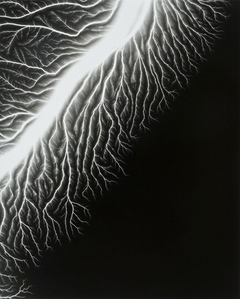"Light of Day" on ArtForum.com
06/04/13

“Light of Day” is featured by ArtForum.com in “Critics Picks” a select review of shows worldwide. The review is written by Kris Paulsen, Assistant Professor of Film, Video and New Media in the History of Art Department and Film Studies Program at The Ohio State University.
“Light of Day”
TRANSFORMER STATION 1460 West 29 Street February 1–May 4

Hiroshi Sugimoto, Lightning Fields, 128, 2009, gelatin silver print, 58 3/4 x 47”.
“Light of Day” offers the first presentation of Transformer Station founders Fred and Laura Bidwell’s photography collection and also marks the debut of this new space for contemporary art. The show’s title, however, points beyond these ceremonial unveilings to a meditation on the role of analog photography (“the pencil of nature”) in the digital age. While the former automatically and objectively allowed the sun’s light to draw an image of the empirical world, digital technology now allows man and machine to overwrite what nature dictates. Analog photography may have been pushed into the shadows, but “Light of Day” shows it coming back into view under the guise of the supernatural, the surreal, and the psychedelic.
Examples of post-photographic, sunless artifice—such asHans Op de Beeck’s detail-less images of architectural simulacra and Beate Gütschow’s cut-and-paste pastoral landscapes—highlight the presence of both the artist and the machine in the new era of photography. Yet despite the presence of new techniques and technology in “Light of Day,” it is analog photography that emerges as uncanny and unfamiliar. Take, for instance, Abelardo Morell’s Camera Obscura Image of the Philadelphia Museum of Art East Entrance in Gallery with a de Chirico Painting, 2005, which employs a basic scientific principle behind photographic realism—that a pinhole of sunlight will project an upside-down image into a dark space—and renders it surreal: The facade of the Philadelphia Museum of Art is here inverted and overlaid upon de Chirico’s The Soothsayer’s Recompense, 1913, exposing analog photography as more dreamlike than any digital simulation.
Analog photography can be electrified without going digital: Hiroshi Sugimoto’s Lightning Fields, 128, 2009, captures with fine detail an image of light itself: In the pitch blackness of a dark room, he applied a bolt of electricity directly to a sheet of film to record the branching structure of unharnessed energy. The digital and analog photographs in “Light of Day” picture the struggles and collaborations between humanity, nature, and machine, a drama well suited for this former electrical substation turned crucible of contemporary art.
Kris Paulsen


